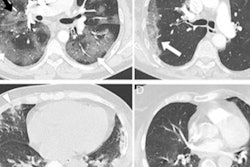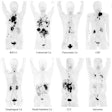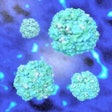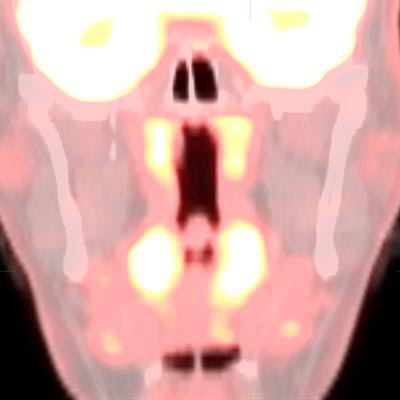
The COVID-19 omicron variant appears to cause an unusual imaging pattern on FDG-PET/CT scans in cancer patients, according to a statement released January 14 by the Society of Nuclear Medicine and Molecular Imaging (SNMMI) COVID-19 Task Force.
"Task Force members have recently observed an unusual imaging pattern on FDG-PET/CT or FDG-PET/MR that appears to correlate with the COVID-19 infection," the SNMMI stated.
Unlike the FDG-PET/CT pattern seen with infections from previous strains of SARS-CoV-2, with principal involvement of the lungs, this new array of findings is primarily centered in the upper aerodigestive tract and cervical lymph nodes, the task force reported.
Specifically, there is prominent, symmetric FDG uptake throughout the nasopharynx, oropharynx, and tonsils (Waldeyer's ring) with or without associated FDG-avid cervical lymphadenopathy, particularly in the suprahyoid neck.
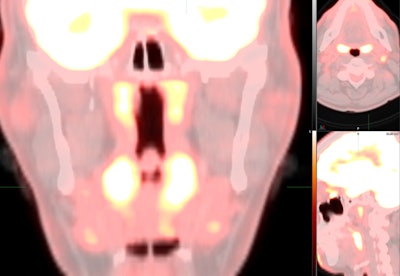 FDG uptake on PET/CT in nasal-associated lymphoid tissue in a cancer patient infected with the COVID-19 omicron variant. Image courtesy of Dr. Munir Ghesani.
FDG uptake on PET/CT in nasal-associated lymphoid tissue in a cancer patient infected with the COVID-19 omicron variant. Image courtesy of Dr. Munir Ghesani.Dr. Munir Ghesani, chief of nuclear medicine and molecular imaging at Mount Sinai Health in New York City and chair of the SNMMI COVID-19 Task Force, said he began noticing what appeared to be a consistent pattern about a week ago and quickly confirmed similar findings on FDG-PET/CT in cancer patients with colleagues in Boston, Los Angeles, and Atlanta.
"This was very new and exciting and disturbing at the same time," he told AuntMinnie.com. He added that the pattern has been seen in both adults and children.
The task force suggested that physicians take the pattern into consideration at the time of FDG-PET/CT interpretation. However, because this new pattern "can by no means be diagnostic of COVID-19 infection," the group has made the following recommendations:
- Check patient records for recent positive COVID-19 tests.
- Determine if the patient is at higher risk of infection based on current symptoms or due to recent exposure or travel. If so, a recommendation can be made to test for COVID-19 in the appropriate setting.
- Compare with prior FDG-PET/CT examinations and the patient's history to determine if this represents a chronic inflammatory/reactive process or stable malignancy, such as lymphoma.
In addition, various differential diagnostic possibilities should be considered if the omicron pattern is new or if there is interval progression, including but not limited to infection with other viruses such as the Epstein-Barr virus, malignancy, and bacterial infections.
Lastly, since the pattern has also been seen in children and younger adults, it should be interpreted cautiously in light of potential normal increased physiologic activity. Correlation with history and symptoms and comparison to prior examinations is recommended, the task force concluded.








